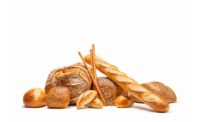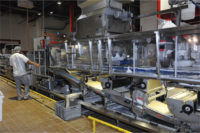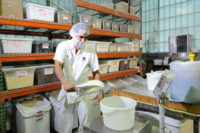Artisan On Automatic
By Dan Malovany
By mixing and matching equipment from around the world, Turano Baking has taken the art of baking to a whole new level.
Invest during bad times to prepare for when things go well. Ideally, that’s a motto every industry should follow. In reality, however, it’s easier said than done. Most businesses tend to pour money into their operations during good times and cut capital expenditures when the going gets tough. For many companies, doing the opposite goes against all business principles, let alone human nature.
But not for Turano Baking Co. Just like a good stockbroker who knows to buy low and sell high, the company invested millions of dollars in its Berwyn, Ill., bakery two years ago — adding a 30,000-sq.-ft. addition — when many executives thought the industry had hit rock bottom, notes Renato “Ron” Turano, the company’s chairman.
“We expanded during the low-carb times because we wanted to be ready when the market rebounded,” he explains. “We wanted to invest in a way that will help us for the next five to 10 years.”
Specifically, the addition houses two state-of-the-art lines that produce a variety of Old World-style breads and rolls. The artisan line makes ciabatta, as well as the company’s signature Pane Turano, a crusty 2-lb. round loaf that’s actually baked upside down. The plant’s new, adjacent French bread line cranks out Turano’s extra-long, 36-in. loaves, which are more often than not cut into rolls for the company’s burgeoning foodservice business.
The artisan line also turns out 1,500 loaves an hour of Pane Turano, which before had been produced on a semi-automated makeup line and hand-loaded into a revolving tray oven. The French bread line can bake 3,000 strings an hour or upward of 18,000 rolls.
Overall, the 165,000-sq.-ft. plant houses six automated and semi-automated lines that produce hundreds of varieties of products, ranging from Kaiser, sub, sourdough, ciabatta, French and dinner rolls to baguettes, raisin walnut bread, country loaves and a plethora of rounds, panned bread and custom-formulated institutional foodservice products.
Turano’s Berwyn bakery nicely complements the company’s Knead Dough facility in Bolingbrook, Ill. That facility houses seven automated production lines that produce long runs of rolls that are frozen for foodservice at a national distribution level. Turano has 100 routes that distribute fresh product to retail and foodservice accounts throughout Chicagoland and southern Wisconsin.
“We’re seeing a large increase in par-baked products and with foodservice chains baking off in-house,” notes Joe Turano, Berwyn plant supervisor.
The breadth of variety at the Berwyn plant is staggering. For instance, the company produces more than 25 different types of French baguettes and rolls, and 20 stock-keeping units (SKUs) of ciabatta.
Currently, the company is adjusting the production flow among its various lines to maximize capacity, streamline change-overs and improve efficiency throughout the Berwyn bakery’s numerous short and long runs. Some lines have more than 30 changeovers per day. But because of their speed and capacity, the new lines have more limited runs.
“We’re going to be running [the new lines] around the clock shortly,” Joe Turano remarks.
Biga is Better
Automating artisan bread production — specifically Pane Turano, which also comes in a 3-lb. foodservice variety — was no easy task. In fact, it took about five years of research and trips to dozens of bakeries throughout Europe to see the latest systems in action. Today, the artisan and French bread lines include equipment from around the world, including Japan, Germany, Italy, France and the United States. The French bread line even has extra-hard, warp-resistant peel boards from Finland.
Production of artisan bread actually begins the day before when the bakery makes up a biga — an Italian sponge made up of water, flour and yeast that is fermented overnight in white, 55-gallon containers. The biga helps provide the distinct flavor, open-cell structure and crispy eggshell-like crust for the company’s ciabatta bread and rolls, Joe Turano explains. The bakery also adds a touch of extra virgin olive oil to some of its products for machinability and added flavor.
On the artisan line, flour flows from one of two 100,000-lb. silos through a sifter and scale into a continuous spiral mixer, which consists of a carousel with three bowls that rotate and create non-stop batches of dough. Depending on the product, the batches rest anywhere from 30 minutes to 3 hours after mixing. This relaxes the dough.
“We have to mix the dough at a cooler temperature because the fermentation raises its temperature prior to makeup,” Joe Turano says.
Afterward, the bowls automatically are elevated, and the dough is chunked onto a conveyor that leads to a flour duster and sponge roller that sheets the dough using a stress-free process. A second sheeting station further sheets the dough in a gentle way that maintains the cell structure of the ciabatta rolls, which were being made during Snack Food & Whole Bakery’s recent visit to the plant.
The dough sheet then passes through a roller cutter, which can divide the sheet into four to eight pieces, depending on the width of the product. After traveling on finger conveyors, which separate the dough strips, a conveyor then divides them into individual pieces.
Three separate PLCs control makeup on the versatile line, which can be outfitted with a variety of die cutters to create round, rectangular or even diamond-shaped products. It also features rounding bars for making Pane Turano and moulders for producing demi or large baguettes. Focaccia and other flatbreads also can be made on this line. Although the bakery currently doesn’t top any of its products, the line is capable of doing so.
In order to automate its Pane Turano production, the line has a marking belt, where operators align six of the 2- or 3-lb. round dough pieces, which then glide exactly onto peel boards passing underneath the belt. A shutter system is available to line up baguettes onto peel boards.
After proofing for one hour in an overhead, serpentine proofer, products are hand-scored, if necessary, and head to a 132-ft. granite tunnel oven, the largest oven of its kind in the world. The stone-plated oven is 14-ft. wide and big enough to bake 12 Pane Turano loaves at a time.
Next, products pass by a small brush and vacuum station, which removes excess flour, before spending an hour in a spiral cooler prior to sliding down a gravity shoot to the packaging area. Some bread products weighing more than 1 lb. need additional cooling time prior to slicing.
Laser-Guided Production
On the French bread line, 800-lb. batches of dough are produced in one of two horizontal mixers that are fitted with glycol jackets to keep the dough cool. On warmer days, chilled water might be used to maintain proper dough temperature. The line produces both traditional French and wheat baguettes and rolls.
After being dumped into troughs, the dough is elevated to the hopper of a five-pocket divider and travels through a cone rounder before going through a series of stages that mould and stretch the dough pieces.
Following rounding, the pieces receive the first of three intermediate proofing sessions in order to rest and relax them prior to stretching them out. Total intermediate proofing time during the process can exceed 20 minutes, Joe Turano says.
The dough pieces then pass through a sheeter, cross moulder, pressure board and curling chain before going through a set of three dough piece extenders. Between each extender, the dough receives rest time to relax.
Next, a conveyor deposits the string pieces onto peel boards, which travel to a station that shoots a series of red laser beams onto the boards, which allow production employees to line up the pieces and manually extend them before the products pass through a straightening device.
After going through a serpentine proofer, the strings are cut into roll pieces. A revolving trim remover flips the end pieces, or scrap, off the conveyor and into a sanitary container. The scrap is reworked into future batches.
Currently, the line has an automatic, straight-scoring system with a series of blades that can be adjusted to handle a slew of product shapes and sizes. The company plans to install automatic, angle-scoring systems in the near future.
Products from eight peel boards, or 32-40 loaves of product, are loaded up into the 100-ft. mesh tunnel oven. The oven has steam capability, in addition to adjustable top and bottom burners, to handle a variety of products. Items then enter a spiral cooler, located on top of the oven because of space constraints, prior to entering the packaging area.
New Training Facilities
Turano’s Berwyn bakery has four flexible packaging lines that can handle everything from sliced panned breads and panini loaves to hoagie rolls, French rolls and hamburger and hot dog buns for both retail and foodservice channels.
From packaging, products are sent to a recently expanded warehouse that now has 14 slots for loading route trucks indoors. The warehouse also has three tractor trailer spots — one for incoming ingredients and two for outgoing product — and ample space for loading trailers that carry product to its main freezer located at the Bolingbrook, Ill. plant. Additionally, the company recently expanded the freezer at its Berwyn facility, where short-run products such a raisin-walnut loaves are held for local distribution.
During the remodeling process, Turano also moved its breadcrumb line up to the second floor above the expanded warehouse. Typically, breadcrumbs are bulk-packed and shipped to food processors that produce breaded meats, snacks and entrees.
The company also is in the middle of remodeling its headquarters in an open-air design that allows natural sunlight to shine into its offices. Employees have a new lunchroom, two locker rooms and training facilities where plant safety classes and other classes are held.
In addition, the bakery is building a new kitchen and demonstration area where its in-house chef and sales staff can create upscale sandwiches and other gourmet menu items to show off the versatility of Turano’s breads and rolls. Ron Turano says that educating its customers about innovative ways in which breads and rolls can be used is an ongoing process that continues to pay big dividends in the long run.
“It’s hard to believe that most people didn’t know what ciabatta was 15 years ago,” he observes. “Now, you’re seeing ciabatta sandwiches at [quick-serve] restaurants. The whole country is picking up on the product.”



